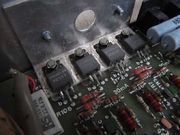Équipement audio
Cette page traite des équipements audio, en particulier des radios, des systèmes Hi-Fi et des lecteurs de CD et cassettes portables, et de ce que vous pouvez espérer réussir à en faire.
Résumé
Les appareils audio peuvent très souvent être réparés. Dans le cas d'un article multifonctionnel tel qu'une chaîne HIFI, la première étape consiste à déterminer quelles fonctions fonctionnent encore et lesquelles ne fonctionnent plus. Les sections qui manipulent le plus de puissance sont les plus susceptibles de tomber en panne. Les transistors grillés dans la sortie audio et les condensateurs électrolytiques dans l'alimentation sont relativement faciles à remplacer.
Les problèmes mécaniques peuvent être plus délicats. Il est possible de remplacer les courroies en caoutchouc usées, mais elles peuvent être difficiles à installer dans le cas d'un lecteur de cassettes. Les platines sont plus simples, mais le fonctionnement d'un changeur automatique peut être difficile à comprendre.
Une page séparée traite des lecteurs de CD et DVD.
Sécurité
- Il peut être très dangereux de faire fonctionner des appareils alimentés par le secteur sans capots. N'essayez pas de le faire si vous n'êtes pas totalement capable de comprendre et de gérer les risques, tant pour vous-même que pour les personnes présentes.
- Les amplificateurs audio, même de puissance modeste, peuvent fonctionner avec des tensions internes assez élevées, souvent de l'ordre de 50 à 100V. Bien qu'elles ne soient pas aussi dangereuses que celles du secteur, ces tensions doivent néanmoins être traitées avec attention.
- Les radios et les amplificateurs à lampes ne sont pas courants, mais si vous avez affaire à l'un d'entre eux, n'oubliez pas qu'il contient des tensions élevées qui peuvent être tout aussi dangereuses que celles du secteur. N'oubliez pas non plus que les condensateurs de lissage peuvent conserver une charge suffisante pour vous donner un méchant choc même après que le secteur a été débranché.
Amplificateurs
Power supplies are covered in their own page. Look out in particular for bulging electrolytic capacitors, especially if there is excessive hum from the loudspeakers. Bear in mind though that overheating components or a fuse which repeatedly blows may be a symptom of a problem elsewhere.
The power output stage often consists of two or two pairs of transistors connected in series between the positive and negative supplies. There will be one set for the left and one for the right in a stereo amplifier. These may be either bipolar or field-effect types. Bipolar transistors can be subject to thermal runaway: overheating causes an increase in the current drawn, which in turn causes the overheating to get worse, and so on until the transistor fails. This often results in an effective short circuit between the positive and negative supplies, causing a fuse to blow, sometimes spectacularly.
You should remove the transistors for testing and replace them as a pair. They will often have different numbers and it's essential to fit the right one in the right place. Take care to ensure good thermal contact with the heat sink, cleaning off and replacing heatsink paste if used, and not loosing an insulating washer if fitted.
Tuners and radios
First of all, check whether there is any possibility that the batteries (if used) have at any time been installed the wrong way round. If so, there is a strong possibility that this would have done irreparable damage.
Corrosion of the contacts in the battery compartment is common, caused by leaking chemicals from dead batteries which have been left in the device. Clean the contacts with switch cleaning fluid or isopropyl alcohol on a tissue or cloth.
Switches and push-buttons can also be troublesome. They are covered in their own page.
Modern equipment often uses a digital volume control activated through push-buttons or a rotary encoder, but formerly a potentiometer was universally used. This can cause loud crackles from the loudspeakers when it gets old or worn. Remediation is covered in the section on potentiometers.
Tuners often contain adjustable trimmer capacitors or coils with adjustable ferrite cores. These are set up and sealed in the factory. Never try "tweaking" them as their proper adjustment requires laboratory equipment such as a signal generator and oscilloscope, without which it would be almost impossible to do anything but make things worse.
DAB radios ought to be very reliable as they have few mechanical parts, but nevertheless failures are not uncommon. Firstly, look for broken wires or connections and signs of poor workmanship such as bad solder joints. A faulty power supply is another possibility. Check whether the device works on batteries but not on mains. If it uses a separate power adapter, test its output voltage with a multimeter. If it runs directly off the mains then it will have an internal power supply. In this case, extreme caution must be observed if any tests are carried out with the device open. Only do so if you are completely confident that you can do so safely. Whether the unit runs on mains or batteries, it may well have internal circuitry to provide different voltages for the analogue and digital sections. You may be able to identify this and test it with a multimeter.
Record Players and Cassette Decks
Problems with these are most often mechanical, in particular, worn or perished belts or dirt build up, possibly in bearings. A careful visual inspection whilst trying to operate the part in question may show what is wrong.
Replacement belts are available from online sources. The mechanisms tend to be quite intricate so the degree of disassembly required may range from a simple job if the replacement belt can be simply looped over its pulleys, to a complex one requiring care and patience if the pulleys are less accessible.
Intro to Cassette Recorder Operation, Maintenance, and Repair at Instructables.com gives an excellent introduction to fixing cassette decks of various sorts.
